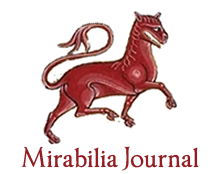Fables in Bayeux Tapestry: interrelations between margin and center in the narrative of the 11th century conquering of England
Jaime Estevão dos REIS, Adriana ZIERER, Lúcio Carlos FERRARESE
Original title: As fábulas na Tapeçaria de Bayeux: inter-relações entre margem e centro na narrativa da conquista da Inglaterra no século XI
Published in Art, Criticism and Mysticism
Keywords: Bayeux Tapestry, England., Fables, Margin.
This article’s objective is to comprehend the role that the fables depicted in the marginal illustrations of the Bayeux Tapestry perform towards the main narrative. We present the historical context of the source’s creation, concerning the Battle of Hastings of 1066, the relations between the narrative and its context, with the fables. Thus, we have observed that these perform an auxiliary role for the comprehension of the main narrative, presenting exemplary and moralistic stories that interact directly with the central images.
Faces in Pieces
David PARLETT
Published in Games from Antiquity to Baroque
Keywords: Abstractionism and representationalism, Ancient and medieval board games, Board and card games, Early card games, Perceptions of play, Properties of a game, Race games, Traditional and proprietary games, War games.
The perception of game pieces and boards as actors and theatres of play is a natural human propensity and has been expressed in many ways throughout the history of games. This paper explores some of the ways, with particular reference to chess and card games, that enable us to appreciate how people of the Past drew on themselves and their surroundings to breathe life into otherwise abstract procedures of formal games.
Fall and redemption of the knight in Curial e Güelfa
Sonia GROS LLADÓS
Original title: Caída y redención del caballero en Curial e Güelfa
Published in Returning to Eden
Keywords: Anthropocentrism, Chivalric novel, Curial e Güelfa, Fifteenth Century, Italian Humanism.
In this paper we propose a reading of the Catalan chivalric novel Curial e Güelfa, following the moral itinerary of the hero from the perspective of the Scriptures, with the intention of adequately assessing the profane character of the text, in our opinion, primarily anthropocentric, secular, and pagan, linked to an Italian humanistic context.
Father José Maurício Nunes’ Sinfonia Fúnebre (1790): an analysis employing Robert Gjerdingen’s Musical Schemata
Ernesto HARTMANN
Original title: A Sinfonia Fúnebre (1790) do Padre José Maurício Nunes Garcia (1767-1830): análise com o conceito de Schema Musical de Robert Gjerdingen
Published in Music in Middle Ages and Early Modernity
Keywords: Father José Maurício Nunes Garcia, Galant Style, Schemata, Sinfonia Fúnebre (1790).
In this work I investigate the use in Father José Maurício Nunes Garcia’s Sinfonia Fúnebre (1790) of what the American musicologist Robert Gjerdongen calls Schemata. According to Gjerdingen, Schemata are abstract structures that were part of the Galant Style, either in Central Europe as in the Colonies, as Brazil is the case. In order to do so, I make a brief overview of the editions available for analysis; review of the Schemata concept in Gjerdingen and other authoritative authors; elaborate a table that articulates form, tonality, Schemata bar by bar; and last, exemplify the use of this Schemata in musical excerpts of the work. I conclude that the systematic and very sophisticated use of the Schemata by the Brazilian composer demonstrates that he is by no means just a mere imitator of the Galant Style, but instead, a great master of this idiom and capable to organize the Schemata at his will to fulfill his expressive needs as it is the case in this Sinfonia Funebre.
Feasts, Theatre and Power
Lenora Pinto MENDES
Original title: Festa, Teatro e Poder
Published in Society and Culture in Portugal
Keywords: City, Feasts, Monarchy.
The Avis Dynasty took power in Portugal in the fourteenth century with the support of the population of the cities of Lisbon, Porto and Coimbra. From the beginning, it made use of the popular festivities as a form of support and legitimation. Throughout the entire dynasty, in the royal festivities the urban segments of the cities were present, reinforcing the vassal contract between the kings and the cities. In the reign of D. Manuel the theater will be part of this dynamic and will highlight Gil Vicente, first Portuguese playwright who acted in the courts of D. Manuel and D. João III, creating theatrical acts for the most important moments of the royal festivities such as births, coronations and funerals.
Feminine elites in Galician towns during the Late Middle Ages
Miguel GARCÍA-FERNÁNDEZ
Original title: Las élites femeninas en las ciudades gallegas de la Baja Edad Media
Published in Mulier aut Femina. Idealism or reality of women in the Middle Ages
Keywords: Galicia, Late Middle Ages, Towns, Urban elites, Women.
Women from different social groups lived in medieval towns. However, historians have studied more closely women working outside their homes in various trades and, far less, women that were part of the urban oligarchies. Therefore, the aim of this paper is to analyze female elites in Galician towns during the Late Middle Ages, indicating who they were and what their role within the oligarchy was. So, we will know some names, places, relationships, public actions and attitudes to death of those female elites.
Femininity in tension. Iconographic itineraries from Tellus to the woman on the beast of the Turin Beatus (12th century)
Nadia Mariana CONSIGLIERI
Original title: Lo femenino en tensión. Recorridos iconográficos de Tellus a la mujer sobre la bestia del Beato de Turín (siglo XII)
Published in
Keywords: Greco-Roman formulas, Lust, Manticore, Tellus, The Prostitute of Babylon and the beast, Turin Beatus.
Figure and meaning of Venus in the artwork of Botticelli
Laura CASADO BALLESTEROS
Original title: Figura y significado de Venus en la obra de Botticelli
Published in
Keywords: Botticelli, Mythology, Médici, Neoplatonism, Renaissance, Venus, Virgin.
The representation of Venus in Botticelli’s painting has always been present, not only to reflect the goddess as another image, but as a representation in which the painter goes beyond the mythological theme that the goddess occupies, reflecting a whole series of elements that are part of the world of the symbol. As well as the importance of the philosophical lessons of Neoplatonic character in the subject that occupies to us, that already were object of debate in this epoch and will be us of great utility to establish a correct and coherent interpretation of the hidden message of these mythological works.
Flavors of Celebration: Food and Public Festivities in Al-Andalus
Mourad EL FAHLI
Original title: Sabores de Celebración: Alimentación y Festividades Públicas en Al-Andalus
Published in Games from Antiquity to Baroque
Keywords: Al-Andalus, Culinary Traditions, Cultural Elements, Entertainment, Festive Celebrations, Religious Diversity.
This scholarly investigation intricately navigates the captivating juncture where festive celebrations intersect with culinary traditions within the historical context of Al-Andalus, offering nuanced insights into their pivotal function as forms of public entertainment. By immersing into historical archives, literary compositions, and culinary manuscripts, this scholarly inquiry unveils the multifaceted interplay of Islamic, Christian, and Jewish influences, culminating in a vibrant and culturally intricate culinary panorama. The analytical exploration delves into iconic celebrations such as ʿĪd al-Fitr and ʿĪd al-Adḥā, where Islamic practices seamlessly intertwined with the fabric of Arabic culinary heritage. Similarly, festivities such as al-ʿAnṣara and Nawrūz, which emanated from Christian and Jewish traditions, eloquently demonstrated the harmonious convergence of diverse cultural facets. Manifested through opulent arrays of tantalizing gastronomic offerings, these celebratory banquets embodied notions of opulence, camaraderie, and collective elation. The Andalusi disposition, oscillating between restrained modesty and opulent abundance, contributed an additional stratum of intricacy. In its essence, the cultural synthesis discernible within Al-Andalus vividly underscores how the amalgamation of multifarious culinary traditions served as a bridge between communities, facilitating the commemoration of unity during an embrace of religious diversity.
Flexibility of musical hearing
Gaspar PAZ
Original title: A flexibilidade da escuta musical
Published in Art, Criticism and Mysticism
Keywords: Aesthetic experience, Artistic criticis, Artistic languages, Flexible listening, Music.
Herein we analyze some aspects of the artistic criticism and aesthetic experience, which stand out in Gerd Bornheim’s interpretations. For him, the critical disposal should follow the creative process and the expressive praxis. In this way, we will assume musical language as an inflexion point highlighting the contrast between two forms of perception: the intellectualist listening and flexible listening to the music. Such instances symbolize the buildup of an interpretative and practical boldness in which the role of sound is stressed. There are at least two plausible hypotheses in bornheimnian approach. The first one, phenomenological, handles the music as language towards a dialectic of social relations and it takes into account the historical alternations of subjectivity. The second trends to a broader analysis of artistic expressions, in which the dialogue between music, theater, poetry, cinema and art is emphasized. It is therefore important to appreciate the critical relevance of Bornheim’s work and the special place he assigns to the relationship between arts, philosophy and politics.






















































































